Insider’s guide to Euro 2012
As the start of Euro 2012 approaches, it’s time to start planning ahead to make the most of your time in Poland and Ukraine. From pretty market squares and museums charting the region’s complex history to lively nightlife, we uncover the best of the eight host cities.
POLAND
Poland has a rich cultural heritage that’s exhibited in chocolate-box cities with expansive squares and streets brimming with rows of narrow townhouses that are stacked together like colourful rounds of toast.
Getting around Poland couldn’t be easier during Euro 2012, with high-speed rail links and additional bus services. The Polish Pass allows fans to tailor-make their own stay online with options to add accommodation, travel and medical insurance.
Gdańsk
Stadium: PGE Arena Gdańsk (44,000 capacity).
Key matches: Spain v Italy (10 June), quarter-final (22 June).
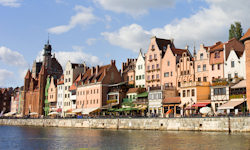 Admire the baroque buildings alongside Gdańsk Port
Admire the baroque buildings alongside Gdańsk PortiStockphoto / Thinkstock
About Gdansk: Gdańsk, the most northerly host city of the tournament, is a thriving port with a lively Old Town bursting with baroque houses, independent shops and quaint cafés – its Gothic cathedral St Mary’s Basilica is the largest in Poland.
The city has the notoriety of being the place where World War II first began, and it was also the birthplace of the Solidarity trade union movement. Fascinating museums documenting both events provide an insight into the city’s proud identity.
If you’re looking for an authentic souvenir, head to Ulica Mariacka (Mariacka Street) with its numerous craft stalls selling a range of goods including amber, which is found in abundance in the region.
Where to celebrate: High 5, on the fifth floor of the Hilton Hotel (Targ Rybny 1), has magnificent rooftop views of the city.
Top tip: Head to the seaside town of Sopot, a 15-minute train ride away. The spa town has an expansive beach, the longest wooden pier in Europe and thriving nightlife.
Poznań
Stadium: Municipal Stadium (43,000 capacity).
Key matches: Ireland v Croatia (10 June) Italy v Ireland (18 June).
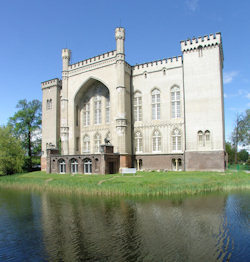 Use the Poznań City Card for discounts on attractions
Use the Poznań City Card for discounts on attractionsiStockphoto / Thinkstock
About Poznań: While football aficionados may know Poznań from the celebratory jig performed by fans of its club Lech Poznań, the city is also famed for being the home of the first Polish kings.
Ostrów Tumski (Tumski Island), where the kings once lived, has history oozing out onto its shores and it houses a number of important religious buildings, including the 2,000-year-old Basilica of St Peter and St Paul.
If you’re really looking to get a taste of the city, head to Lech Brewery, which offers guided tours, including the chance to see the bottling process in action – just don’t forget to try a glass or two in the on-site pub.
Where to celebrate: Stary Rynek (Old Market Square) is a thriving hub with funky bars and restaurants, including Brovaria (Stary Rynek 73-74), a classy tavern with beers brewed on site.
Top tip: Make use of the Poznań City Card, which gives free access to museums and transport, as well as discounts to restaurants and hotels.
Wrocław
Stadium: Stadion Miejski (43,000 capacity).
Key matches: Russia v Czech Republic (8 June), Czech Republic v Poland (16 June).
About Wrocław: Located on the banks of the River Oder in southwest Poland, Wrocław is a city made up of many islands, each interconnected by a network of bridges.
The main square Rynek (Market Square) is the second biggest medieval market square in Europe and is lined with bustling watering holes, including one of the oldest pubs in Europe, Piwnica Swidnicka (Rynek Ratusz 1).
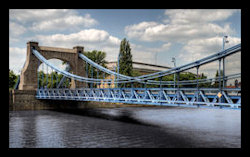 Wrocław has more than 100 bridges
Wrocław has more than 100 bridgesiStockphoto / Thinkstock
Art aficionados should spend time gazing at the giant Racławice Panorama, a vast cylindrical painting depicting the Battle of Racławice.
Where to celebrate: The main fan zone is in Rynek, but there are numerous opportunities to party throughout the city. Try Casa de la Musica (Rynek Ratusz 11-12) for Cuban rhythms or Firlej Club (Ulica Grabiszyńska 56) for live jazz and rock.
Top tip: Leave your thoughts for your lover behind by securing a padlock to Ostrów Tumski Bridge.
Warsaw
Stadium: National Stadium (59,000 capacity).
Key matches: Poland v Greece (8 June), quarter-final (21 June), semi-final (28 June).
About Warsaw: Poland’s capital was painstakingly rebuilt after near destruction by German forces during WWII, but it’s now a thriving, modern city marked with an abundance of green spaces, red-tiled roofs and copper-domed churches.
Warsaw is split in half by the Vistula River, which has a number of river beaches where visitors can relax, take part in sporting activities or sunbathe during the summer months.
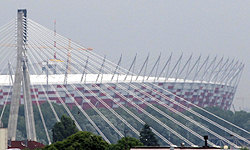 Catch the action at Warsaw's National Stadium
Catch the action at Warsaw's National StadiumCreative Commons / jorgebrazil
For great views of the city, take a lift up Pałac Kultury i Nauki (Palace of Culture and Science), the tallest building in Poland. It’s right next to the fan zone in Plac Defilad (Parade Square).
Where to celebrate: Much of the night-time activity centres on Nowy Świat (New World Street). If you’re looking to mingle with fellow fans, try Legends Bar (Ulica Emilii Plater 25), an upmarket British sports bar.
Top tip: If you’re travelling to Warsaw by car, make use of the park-and-ride areas constructed especially for the tournament. Shuttle buses link the car parks to the stadium.
UKRAINE
Dominated by Kiev in tourism terms, Ukraine has a chance to show off more than its beautiful capital during Euro 2012. The other host cities of Lviv, with its UNESCO World Heritage-listed Old Town; cultural Kharkiv; and industrial Donetsk each have unique characters.
Recently installed high-speed rail connections will make it easy for fans to travel between the host cities, while free transport on match days and mobile ‘fan embassies’ make life easier for fans in what can often be an overwhelming country with its Cyrillic signage.
Lviv
Stadium: Arena Lviv (35,000 capacity).
Key matches: Germany v Portugal (9 June), Denmark v Germany (17 June).
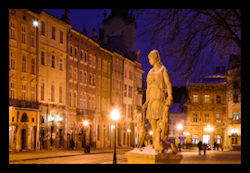 Relax in Lviv's pretty Market Square
Relax in Lviv's pretty Market SquareTop Photo Group / Thinkstock
About Lviv: Lviv, one of Ukraine’s most westerly cities, is credited as being the birthplace of football in the region, at a time when the country was under the rule of the Austrian Habsburg Empire.
Its Old Town, which has buildings dating back to the 13th century, is a UNESCO World Heritage site and includes the pretty Rynok (Market Square) with its charming town hall, tenement houses and fountains.
Unsurprisingly for a city with the nickname “the little Paris of Ukraine” Lviv has culture at its heart. Much of this centres on the tree-lined Prospekt Svobody (Svobody Avenue), the city’s main avenue, which has the famed Lviv Theatre of Opera and Ballet at one end and chess-playing locals at the other.
Where to celebrate: Cheer on your team at Prospekt Svobody, the location for the main fan zone during the tournament. Alternatively, Millennium Club (Chornovol Avenue 2) or the round-the-clock Fashion Club (Sq. Pidkovy 1) will see you into the early hours.
Top tip: If you’ve not had your fill of football, head to the FC Karpaty Lviv museum (M. Voronoho St 3), which is dedicated to the Zeleno-Bili (Green-Whites).
Kiev
Stadium: Olympic Stadium (70,000).
Key matches: Sweden v England (15 June), quarter-final (24 June), final (1 July).
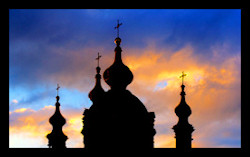 The domes of Kiev's churches dominate the skyline
The domes of Kiev's churches dominate the skylineiStockphoto / Thinkstock
About Kiev: Ukraine’s capital, and the largest host city of the tournament, Kiev is marked by the golden domes of its majestic Orthodox churches. Among these, the Kievo-Pechersky Caves Monastery on the banks of the Dnieper River is the most intriguing with its candle-lit catacombs.
Back above ground, wander along Khreschatyk Street, the main shopping area, and arrive in Maidan Nezalezhnosti (Independence Square), the scene of the 2004 the Orange Revolution. During the tournament the square will be alive with activities as part of the fan zone.
Tours to the site of the Chernobyl nuclear disaster, 130km (81 miles) north of Kiev, are available from the city. Alternatively, visit the National Chernobyl Museum (Khorevyi 1) in the city itself, which has reconstructions, representations and accounts of the horrific explosion.
Where to celebrate: Board one of the party boats that traverse the Dnieper River to disco tunes.
Top tip: Pick up a ‘Z Card’ from the tourist office, which has useful information for fans visiting the city.
Kharkiv
Stadium: Metalist Stadium (39,000 capacity).
Key matches: Netherlands v Germany (13 June), Portugal v Netherlands (17 June).
About Kharkiv: Ukraine’s second largest city borders Russia in the northeastern part of the country and was once the focal point of the former Soviet Republic’s nuclear industry. Today it’s known as a cultural and education hotbed.
Explore the teardrop-shaped Maidan Svobody (Freedom Square), one of the largest city squares in Europe (although locals claim it to be the largest), which has a statue of Lenin at its heart.
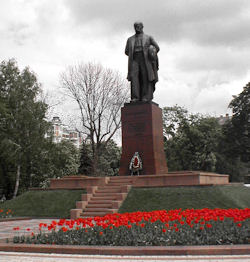 Shevchenko Park is a popular summer spot in Kharkiv
Shevchenko Park is a popular summer spot in KharkivCreative Commons / Anarosa
Bordering the square lies Shevchenko Park, named after the Ukrainian-born poet Taras Shevchenko, not the footballer Andriy. The park houses a zoo and botanical gardens, and is a bustling hive of activity on warm summer evenings.
Where to celebrate: Try one of the many lively bars around Maidan Svobody (Freedom Square), which is home to the fan zone during the championships. Churchill’s Music Pub (Ulica Darwin 9) is a good option for live musical entertainment.
Top tip: Take the cable car above the botanic gardens for far-reaching views of the city.
Donetsk
Stadium: Donbass Arena (53,000 capacity).
Key matches: France v England (11 June), England v Ukraine (19 June), quarter-final (23 June), semi-final (27 June).
About Donetsk: Founded by coalmining Welshman John Hughes in 1869, Donetsk is the most easterly of the Euro 2012 host cities.
Football fans will most likely know Donetsk for its successful team Shakhtar Donetsk whose futuristic stadium, the Donbass Arena, will host the matches during the tournament. The club’s museum, which documents the history of the club, is located at the southern entrance to the stadium.
Donetsk has a number of parks that are ideal for a quick kick about, including the sprawling Scherbakov Park (Central Park); while Park Kovanykh Figur (Forged Figures Park) has elaborate metalwork installations.
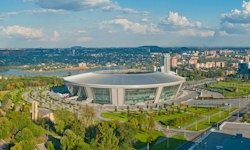 Don't miss the semi-final in the Donbass Arena
Don't miss the semi-final in the Donbass ArenaiStockphoto / Thinkstock
Where to celebrate: The main focal point for eating and drinking is Artema Street, which has the Donbass Arena at one end and a statue of Lenin at the other – the fan zone is next to the stadium. One of the larger venues here is the Chicago entertainment complex (Artema Street 123).
Top tip: Visitors can tap into the city’s mining heritage with a visit to the Solear Salt Mines, 35 minutes away.
WHAT TO TAKE
The apps:
Xe Currency: Makes converting your hryvnia (Ukraine) and złoty (Poland) that little bit easier. Free on iPhone and Android.
Interpret: Useful translator that allows you to tag translations for future use or to share with your friends. Free on iPhone.
Onavo Extend: Shrink your data usage while abroad. Free on iPhone and Android.
Instagram: Capture the winning moment in unique photographic style. Free on iPhone and Android.
The book: Behind the Curtain: Football in Eastern Europe by Jonathan Wilson. Orion. £6.79 from Amazon.
The gadget: Make friends at fan zones and campsites as you re-enact on-field action on a mini table football table. £10.95 from Amazon.
Do you have any Feedback about this page?
© 2026 Columbus Travel Media Ltd. All rights reserved. No part of this site may be reproduced without our written permission, click here for information on Columbus Content Solutions.









 You know where
You know where